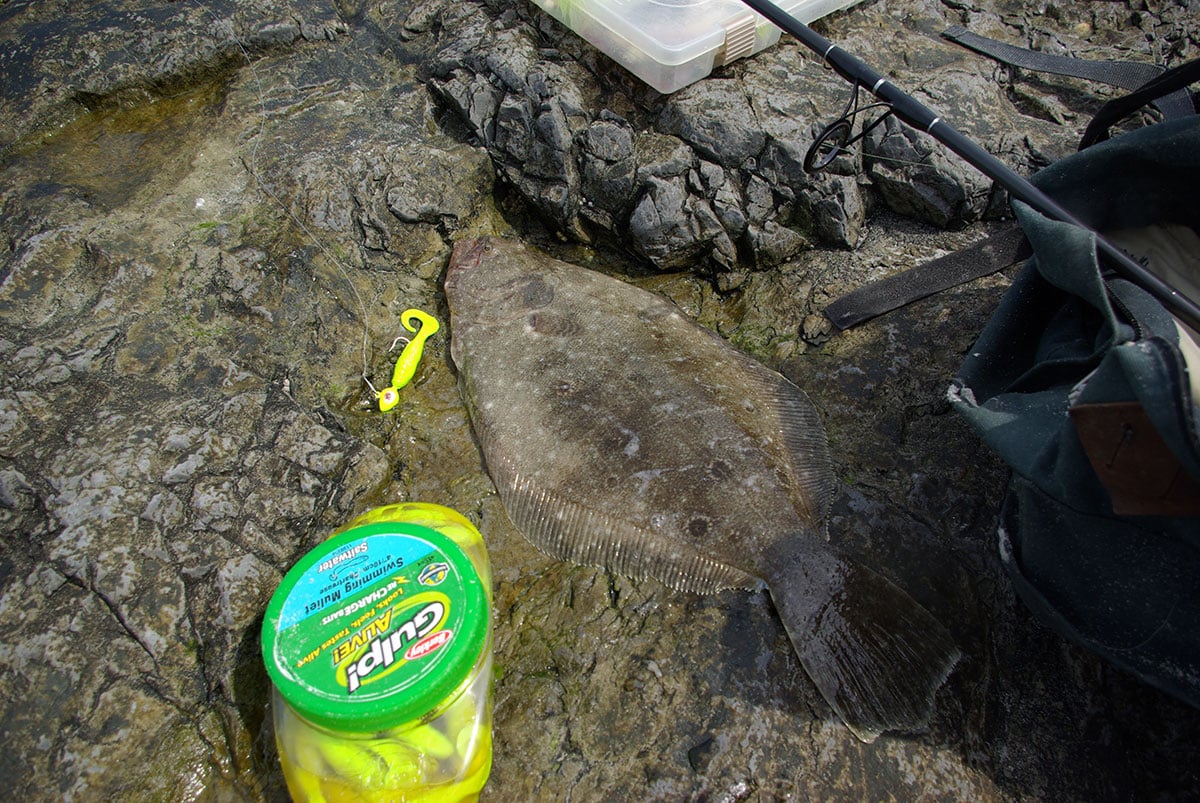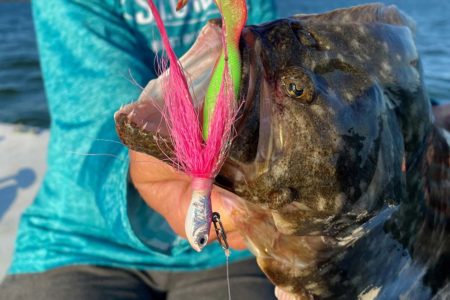
Leave the boat tied up at dock, the shoreline is the place to score with flatties!
During the past decade or longer, I think I’ve caught more keeper class fluke from the surf and land-based platforms than from a boat. Fishing by foot can mean less time expended to catch a limit, less money spent and more fish caught – who can lose?
The key to fishing from the shoreline effectively means focusing on more than just your gear and tactics, but paying close attention to reading the water, currents, times and tides as you need walk and explore the proper ground. The good news is there’s no finer time than the summer to plant your feet down to find some flatties from the sands.
Bait & Tackle
Compared to fishing the oceanside, everything is scaled lighter when fishing fluke from the shoreline. An intimate connection is desired when using light lures and weights to impart a proper presentation. From the surf or sod bank, I utilize a St. Croix 7-foot Tidemaster TSMHF70 or Shimano Terramar TMSE70MB matched with a Shimano 5000 Sustain reel, spooled with 30-pound Power Pro to which I uni-to-uni knot a 48-inch section of 25-pound Seaguar or Yo-Zuri Fluorocarbon Leader.
When hitting inlets and piers, you can amp up your gear. Stick with spinning outfits in the 7- to 7-1/2-foot range rated for medium heavy action to effectively bounce sinker weights to 3 ounces and drift strip baits. Conventional set ups like a Shimano Terramar matched with a Shimano Torium 12 or Penn Fathom can also be used if fishing more of an up and down approach from a pier or bridge setting.
When fishing the suds, hands down, the ultimate fluke-catching device is the simple roundhead bucktail, garnished with proper attractants. Generally a 3/8- to half-ounce white bucktail is the all-around top choice for clean clear waters, but you can mix up color patterns with yellows and chartreuse as well if waters are a little off-color.
You should have a 48-inch section of fluorocarbon leader already connected to your braid running line. On the tag end, tie on the bucktail with a loop knot and tip it with a strip of bluefish or 3- to 4-inch Berkley Gulp Swimming Mullet. The flailing action provided by the loop knot allows for the bucktail to really dance as you pop it.
Roughly 16 inches up from the bucktail, tie a dropper loop and affix a size 3/0 Gamakatsu Octopus teaser hook and tip it with a 4-inch Gulp Swimming Mullet in white.

Presentation & Location
Remember, you are fishing horizontally in the surf and not with the usual vertical approach of a boat, so the more action you can impart in the bucktail as you pop-twitch it as it bounces across the surf sands the better. Cast out and begin to twitch the tip of your rod, reeling in one or two cranks at a time to pick up the slack – the slower the better. A general cast should take you a good two minutes to reel in.
Fluke are fickle, sometimes pouncing on the bucktail immediately, sometimes following it all the way in, literally right up to your feet. A good trick that has claimed plenty of fluke for me is when it gets in the undertow about 6 feet away from my feet, I’ll dance it around in one spot as many times a fluke will strike at the very last opportunity as it comes up the undertow ledge. On clear days, you can witness their pursuit right up to your feet. Fluke hang in packs in the surf so when you do find a fish, work the area hard to pull on the rest of them.
Spot Check – Anywhere on the coast where you can find cuts, sloughs and holes is a good bet, but Sandy Hook and Island Beach State Park are two of my favorite haunts (keep in mind that New Jersey’s regulations allow for a special, two fish and 16-inch minimum size at Island Beach State Park.)
Swashing currents through inlets and piers consistently spark fluke to bite at these locales as both incoming and outgoing tides with moments of current allow flatfish to ambush prey as it ushers on by. Most times, you’ll catch larger model fluke up to 6 or 8 pounds as they tend to hang around inside inlets as currents rip through. Standard bottom rigs work well here consisting of a three-way swivel with sinker clip and appropriate sinker size of 3 to 5 ounces, a 24-inch section of 40-pound leader and a size 3/0 Octopus or Kahle hook on the end tipped with squid/spearing or sand eel.

From an inlet wall, you want to be straight out in front of you to maybe a 30-degree angle for an effective presentation. When fishing off a pier, bucktails can once again be employed though you have to play the tide swing. Fancast with the bucktail, casting upcurrent and letting it sink while twitching the bucktail until it comes to a 2 o’clock position, then reel up and fancast again. The strike zone exists in the 10 to 2 o’clock position for a natural presentation.
Spot Check – Corson’s Inlet, Longport Pier, Manasquan Inlet, Barnegat Inlet, Mantoloking Pier.
Many secret backwater sod bank and river access spots allow for you to hoof it and work bay channels. Fishing sod banks is a combination of the surf and inlet tactics. Usually, bucktails are the way to go once again, but you have to play the tides of the backwaters, once again fancasting from 10 to 2 o’clock position in that window in front of you, allowing the bucktail to drift naturally with the incoming or outgoing tides.
Fluke are aggressive off the banks and inside rivers, and they will follow it tens of yards sometimes before committing. Many times you’ll get “hangers” on the bucktail or teaser where fluke sometimes overplay their hand and miss the strike and sit on top of the lure. Set the hook, and if you miss it, don’t reel in, but let the bucktail hit the bottom again and pop-twitch it without reeling in. Fluke will aggressively hit the lure again immediately.
Spot Check – Manasquan River and behind the barrier islands of Ocean County, Atlantic County and Cape May County. Also remember that if you’re fishing along the Delaware Bayshore in New Jersey, there’s a special 17-inch minimum and three fish bag west of the COLREGS on Delaware Bay.
| BOBBER DOWN |
| It’s not often that surfcasters would think of employing a bobber with live bait in the wash, but later in the summer that’s exactly how many folks are scoring some of their biggest fluke in the Sandy Hook surf. “It actually started with a couple of Brazilian guys who were doing it,” said Phil Sciortino at the Tackle Box in Hazlet, noting how other shop regulars picked up on what these other customers were doing. “It caught on from there,” he said, calling it a great method for fishing solid structure like a deep-edge off a flat or along submerged rocks, jetties or groins.
“Biggest bobber you can get, like a 2-inch bobber, and about 24 inches of leader to a small Octopus hook and just toss a killie into the wash,” Sciortino recommended, advising that folks who get the depth right over submerged rocks simply the crush fluke at certain Sandy Hook hot spots; it’s also a good tactic for calm, windless days in the sandy surf. However, Sciortino said the bobber down fluke tactic typically heats up towards the latter part of the fluke season. “It will be a little later on in the summer, typically around Labor Day,” he said. – J. Hutchinson |
Tides play an important role, but when in the surf, sod bank, inlets or piers, don’t just obey the typical mindset of finding dead high water to fish productively. Though high water is typically the best as it offers plenty of water for them to reside, many times fluke will feed aggressively during the low tide hours as they stage on the insides of sandbars in the surf to suck down morsels of food as they flow over the bar into the slough, especially on the incoming tides. Low tide waters also afford the opportunity to wade out to the sandbar and cast into the deep blue where many fluke retreat during skinny water situations.
The key to land-based fluking is to cover ground, making casts as you move down a sod bank, surf or pier. Once you find some flatties, there will be more hanging in a pack. Don’t leave that spot until you have made at least a dozen or more casts to insure you feel you’ve comfortably cleaned out the pack.
Luck has shined on me when surf fluking, topping out with an 8-pound personal best, and more times than not, I’ve scored my three fish limit at 18 inches in an hour’s time. Hoof it for flatties this summer, you’ll be pleasantly surprised with the results.



